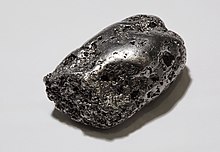Native metal

A native metal is any
Only gold, silver, copper and the platinum group occur native in large amounts.[
Non-metallic elements occurring in the native state include carbon and sulfur. Silicon, a semi-metal, has rarely been found in the native state as small inclusions in gold.[4]
Native metals were prehistoric man's only access to metal, since the process of extracting metals from their ores (

Occurrence
Gold
Most gold is mined as native metal and can be found as nuggets, veins or wires of gold in a rock matrix, or fine grains of gold, mixed in with sediments or bound within rock. The iconic image of gold mining for many is gold panning, which is a method of separating flakes and nuggets of pure gold from river sediments due to their great density. Native gold is the predominant gold mineral on the earth. It is sometimes found alloyed with silver and/or other metals, but true gold compound minerals are uncommon, mainly a handful of selenides and tellurides.
Silver

Native silver occurs as elongated
Platinum group
Natural alloys of the
Copper

Native copper has been historically mined as an early source of the metal. The term
The same deposits of native copper on the Keweenaw Peninsula and Isle Royale were later mined commercially. From 1845 until 1887, the Michigan Copper Country was the leading producer of copper in the United States. Masses of native copper weighing hundreds of tons were sometimes found in the mines.
The spectrum of copper minerals closely resembles that of silver, ranging from oxides of its multiple oxidation states through sulfides and silicates to halides and chlorates, iodates, nitrates and others. Natural alloys of copper (particularly with silver; the two metals can also be found in separate but co-mingled masses) are also found.
Iron, nickel and cobalt
Native nickel has been described in
Metallic
Others
All other native metals occur only in small quantities or are found in geologically special regions. For example, metallic
Native chromium has been found in small grains in Sichuan, China[23] and other locations.[24]
See also
References
- ^ "native metal". Oxford English Dictionary. Oxford University Press. Archived from the original on January 31, 2018. Retrieved 30 January 2018.
- ^ Parker Cleaveland (1822). An elementary treatise on mineralogy and geology. Cummings and Hilliard. p. 521.
- ^ Barthelmy, D. "Aluminum Mineral Data". Mineralogy Database. Archived from the original on 4 July 2008. Retrieved 9 July 2008.
- ^ Silicon, Mindat.org
- ^ Handbook of Mineralogy
- ^ Webmineral data
- ^ Eugenite on Mindat (see related minerals and localities)
- ^ Iridium on Mindat, Relationship of Iridium to other Species – Nichel-Strunz
- ^ Thomas C. Pleger (2000). "The Old Copper Complex of the Western Great Lakes". UW–Fox Valley Anthropology. Archived from the original on 2008-07-05. Retrieved 2007-08-15.
- ^ Mindat with location data
- ^ Native iron in the Handbook of Mineralogy
- ^ Nickel on Mindat with location data
- ^ Native nickel in the Handbook of Mineralogy
- ^ Cobalt on Mindat
- ^ Fleischer, Michael; Cabri, Louis J.; Chao, George Y.; Pabst, Adolf (1980). "New Mineral Names" (PDF). American Mineralogist. 65: 1065–1070.
- ^ Native Molybdenum – Mindat.org
- ^ Lead on Mindat
- ^ Tin on Mindat
- ^ Mercury on Mindat
- ^ Arsenic on Mindat
- ^ Antimony on Mindat
- ^ Bismuth on Mindat
- ^ "Chromium Mineral Data". Webmineral.com. Retrieved 2013-05-09.
- ^ Chromium on Mindat
